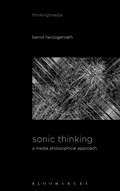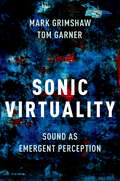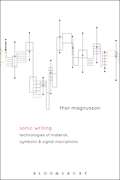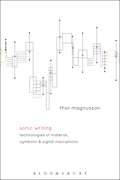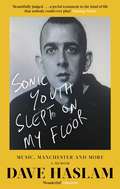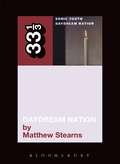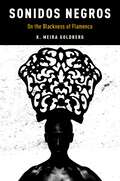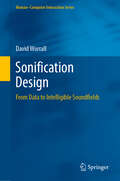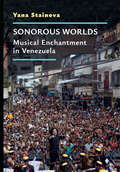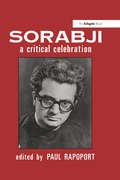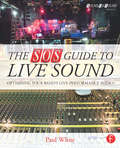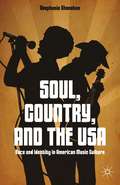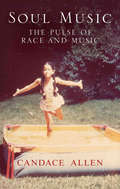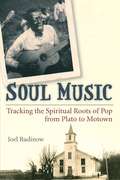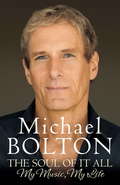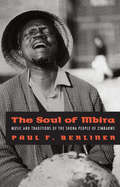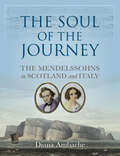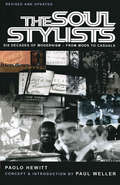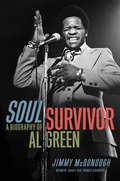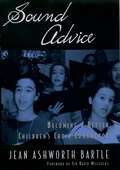- Table View
- List View
Sonic Thinking: A Media Philosophical Approach (Thinking Media)
by Bernd HerzogenrathSonic Thinking attempts to extend the burgeoning field of media philosophy, which so far is defined by a strong focus on cinema, to the field of sound. The contributors urge readers to re-adjust their ideas of Sound Studies by attempting to think not only about sound [by external criteria, such as (cultural) meaning], but to think with and through sound. Series editor Bernd Herzogenrath's collection serves two interconnected purposes: in developing an alternative philosophy of music that takes music serious as a 'form of thinking'; and in bringing this approach into a fertile symbiosis with the concepts and practices of 'artistic research': art, philosophy, and science as heterogeneous, yet coequal forms of thinking and researching. Including contributions by both established figures and younger scholars working on cutting edge material, and weaving artistic responses and interventions in between the more theoretical texts, Herzogenrath's collection provides a lively introduction to a fresh debate.
Sonic Virtuality: Sound as Emergent Perception
by Mark Grimshaw Tom GarnerIn Sonic Virtuality: Sound as Emergent Perception, authors Mark Grimshaw and Tom Garner introduce a novel theory that positions sound within a framework of virtuality. Arguing against the acoustic or standard definition of sound as a sound wave, the book builds a case for a sonic aggregate as the virtual cloud of potentials created by perceived sound. The authors build on their recent work investigating the nature and perception of sound as used in computer games and virtual environments, and put forward a unique argument that sound is a fundamentally virtual phenomenon. Grimshaw and Garner propose a new, fuller and more complete, definition of sound based on a perceptual view of sound that accounts more fully for cognition, emotion, and the wider environment. The missing facet is the virtuality: the idea that all sound arises from a sonic aggregate made up of actual and virtual sonic phenomena. The latter is a potential that depends upon human cognition and emotion for its realization as sound. This thesis is explored through a number of philosophical, cognitive, and psychological concepts including: issues of space, self, sonosemantics, the uncanny, hyper-realism, affect, Gettier problems, belief, alief, imagination, and sound perception in the absence of sound sensation. Provocative and original, Grimshaw and Garner's ideas have broader implications for our relationship to technology, our increasingly digital lives, and the nature of our being within our supposed realities. Students and academics from philosophy to acoustics and across the broad spectrum of digital humanities will find this accessible book full of challenging concepts and provocative ideas.
Sonic Writing: Technologies of Material, Symbolic, and Signal Inscriptions
by Thor MagnussonSonic Writing explores how contemporary music technologies trace their ancestry to previous forms of instruments and media. Studying the domains of instrument design, musical notation, and sound recording under the rubrics of material, symbolic, and signal inscriptions of sound, the book describes how these historical techniques of sonic writing are implemented in new digital music technologies. With a scope ranging from ancient Greek music theory, medieval notation, early modern scientific instrumentation to contemporary multimedia and artificial intelligence, it provides a theoretical grounding for further study and development of technologies of musical expression. The book draws a bespoke affinity and similarity between current musical practices and those from before the advent of notation and recording, stressing the importance of instrument design in the study of new music and projecting how new computational technologies, including machine learning, will transform our musical practices.Sonic Writing offers a richly illustrated study of contemporary musical media, where interactivity, artificial intelligence, and networked devices disclose new possibilities for musical expression. Thor Magnusson provides a conceptual framework for the creation and analysis of this new musical work, arguing that contemporary sonic writing becomes a new form of material and symbolic design--one that is bound to be ephemeral, a system of fluid objects where technologies are continually redesigned in a fast cycle of innovation.
Sonic Writing: Technologies of Material, Symbolic, and Signal Inscriptions
by Thor MagnussonSonic Writing explores how contemporary music technologies trace their ancestry to previous forms of instruments and media. Studying the domains of instrument design, musical notation, and sound recording under the rubrics of material, symbolic, and signal inscriptions of sound, the book describes how these historical techniques of sonic writing are implemented in new digital music technologies. With a scope ranging from ancient Greek music theory, medieval notation, early modern scientific instrumentation to contemporary multimedia and artificial intelligence, it provides a theoretical grounding for further study and development of technologies of musical expression. The book draws a bespoke affinity and similarity between current musical practices and those from before the advent of notation and recording, stressing the importance of instrument design in the study of new music and projecting how new computational technologies, including machine learning, will transform our musical practices.Sonic Writing offers a richly illustrated study of contemporary musical media, where interactivity, artificial intelligence, and networked devices disclose new possibilities for musical expression. Thor Magnusson provides a conceptual framework for the creation and analysis of this new musical work, arguing that contemporary sonic writing becomes a new form of material and symbolic design--one that is bound to be ephemeral, a system of fluid objects where technologies are continually redesigned in a fast cycle of innovation.
Sonic Youth Slept On My Floor: Music, Manchester, and More: A Memoir
by Dave Haslam'Beautifully judged account of the Manchester scene . . . There is something of the fairy tale about Dave Haslam's sage joyful testament to the kind of life that nobody could ever plan, a happy aligning of a cultural moment and a young man who instinctively knew that it was his once upon a time' Victoria Segal, Sunday Times'Witty, sometimes dark, revealing, insightful, everything one could hope for from one of those folk without whom independent music simply wouldn't exist' Classic RockSonic Youth Slept on My Floor is writer and DJ Dave Haslam's wonderfully evocative memoir. It is a masterful insider account of the Hacienda, the rise of Madchester and birth of the rave era, and how music has sound-tracked a life and a generation.In the late 1970s Dave Haslam was a teenage John Peel listener and Joy Division fan, his face pressed against a 'window', looking in at a world of music, books and ideas. Four decades later, he finds himself in the middle of that world, collaborating with New Order on a series of five shows in Manchester. Into the story of those intervening decades, Haslam weaves a definitive portrait of Manchester as a music city and the impact of a number of life-changing events, such as the nightmare of the Yorkshire Ripper to the shock of the Manchester Arena terror attack.The cast of Haslam's life reads like a who's who of '70s, '80s and '90s popular culture: Tony Wilson, Nile Rodgers, Terry Hall, Neneh Cherry, Tracey Thorn, John Lydon, Johnny Marr, Ian Brown, Laurent Garnier and David Byrne. From having Morrissey to tea and meeting writers such as Raymond Carver and Jonathan Franzen to discussing masturbation with Viv Albertine and ecstasy with Roisin Murphy, via having a gun pulled on him at the Hacienda and a drug dealer threatening to slit his throat, this is not your usual memoir.
Sonic Youth's Daydream Nation (33 1/3)
by Matthew StearnsDaydream Nation is the kind of gorgeous monstrosity (born of extremes, rife with difficulties, and mythic in proportion) that can crush the will of the most resilient, well-intentioned listener if the necessary preparations haven't been made. Matthew Stearns explores the album from a range of angles, including a track-by-track analysis and a look at the historical and cultural context within which the album was made. Featuring a foreword by Lee Ranaldo and exclusive interviews with the band, this truly is the definitive guide to Daydream Nation.
Sonic Youth's Daydream Nation (33 1/3)
by Matthew StearnsDaydream Nation is the kind of gorgeous monstrosity (born of extremes, rife with difficulties, and mythic in proportion) that can crush the will of the most resilient, well-intentioned listener if the necessary preparations haven't been made. Matthew Stearns explores the album from a range of angles, including a track-by-track analysis and a look at the historical and cultural context within which the album was made. Featuring a foreword by Lee Ranaldo and exclusive interviews with the band, this truly is the definitive guide to Daydream Nation.
Sonidos Negros: On the Blackness of Flamenco (Currents in Latin American and Iberian Music)
by K. Meira GoldbergHow is the politics of Blackness figured in the flamenco dancing body? What does flamenco dance tell us about the construction of race in the Atlantic world? Sonidos Negros traces how, in the span between 1492 and 1933, the vanquished Moor became Black, and how this figure, enacted in terms of a minstrelized Gitano, paradoxically came to represent Spain itself. The imagined Gypsy about which flamenco imagery turns dances on a knife's edge delineating Christian and non-Christian, White and Black worlds. This figure's subversive teetering undermines Spain's symbolic linkage of religion with race, a prime weapon of conquest. Flamenco's Sonidos Negros live in this precarious balance, amid the purposeful confusion and ruckus cloaking embodied resistance, the lament for what has been lost, and the values and aspirations of those rendered imperceptible by enslavement and colonization.
SONIDOS NEGROS ON BLACKN OF FLAM CILAM C: On the Blackness of Flamenco (Currents in Latin American and Iberian Music)
by K. Meira GoldbergHow is the politics of Blackness figured in the flamenco dancing body? What does flamenco dance tell us about the construction of race in the Atlantic world? Sonidos Negros traces how, in the span between 1492 and 1933, the vanquished Moor became Black, and how this figure, enacted in terms of a minstrelized Gitano, paradoxically came to represent Spain itself. The imagined Gypsy about which flamenco imagery turns dances on a knife's edge delineating Christian and non-Christian, White and Black worlds. This figure's subversive teetering undermines Spain's symbolic linkage of religion with race, a prime weapon of conquest. Flamenco's Sonidos Negros live in this precarious balance, amid the purposeful confusion and ruckus cloaking embodied resistance, the lament for what has been lost, and the values and aspirations of those rendered imperceptible by enslavement and colonization.
Sonification Design: From Data to Intelligible Soundfields (Human–Computer Interaction Series)
by David WorrallThe contemporary design practice known as data sonification allows us to experience information in data by listening. In doing so, we understand the source of the data in ways that support, and in some cases surpass, our ability to do so visually. In order to assist us in negotiating our environments, our senses have evolved differently. Our hearing affords us unparalleled temporal and locational precision. Biological survival has determined that the ears lead the eyes. For all moving creatures, in situations where sight is obscured, spatial auditory clarity plays a vital survival role in determining both from where the predator is approaching or to where the prey has escaped. So, when designing methods that enable listeners to extract information from data, both with and without visual support, different approaches are necessary. A scholarly yet approachable work by one of the recognized leaders in the field of auditory design, this book will - Lead you through some salient historical examples of how non-speech sounds have been used to inform and control people since ancient times. - Comprehensively summarize the contemporary practice of Data Sonification. - Provide a detailed overview of what information is and how our auditory perceptions can be used to enhance our knowledge of the source of data. - Show the importance of the dynamic relationships between hearing, cognitive load, comprehension, embodied knowledge and perceptual truth. - Discuss the role of aesthetics in the dynamic interplay between listenability and clarity. - Provide a mature software framework that supports the practice of data sonification design, together with a detailed discussion of some of the design principles used in various examples. David Worrall is an internationally recognized composer, sound artist and interdisciplinary researcher in the field of auditory design. He is Professor of Audio Arts and Acoustics at Columbia College Chicago and a former elected president of the International Community for Auditory Display (ICAD), the leading organization in the field since its inception over 25 years ago.Code and audio examples for this book are available athttps://github.com/david-worrall/springer/ Here is an excellent review of the book by Dr Gregory Kramer: “Worrall proceeds bravely through the trees and vines of philosophy, information theory, aesthetics, and other contributors to sonification design theory. It’s a feat. He nails all of this down with the specific implementation system he’s designed over many years, and applies his theories to specific problems. In a field of research still in its first half century and setting its bearings in a world where human perception has become a sideshow to machine learning, deep learning, and artificial intelligence, the roots David provides will serve well.” Dr Gregory Kramer is the founding figure in the emerging field of sonification, founded the International Conference on Auditory Display (ICAD) and editor of the first book in the field, "Auditory Display: Sonification, Audification and Auditory Interfaces" (Addison Wesley, 1994).
Sonorous Worlds: Musical Enchantment in Venezuela (Music and Social Justice)
by Yana StainovaEl Sistema is a nationwide, state-funded music education program in Venezuela. Founded in 1975 by economist and musician José Antonio Abreu, the institution has weathered seven jolting changes in government. Hugo Chávez and, after his death, president Nicolás Maduro enthusiastically included the institution into the political agenda of the socialist project and captured the affective power of music for their own aims. Fueled by the oil boom in the 2000s, El Sistema grew over the years to encompass 1,210 orchestras for children and young people in Venezuela, reached almost 1 million people out of the 30 million in the country, and served as a model in more than 35 countries around the world. Sonorous Worlds is an ethnography of the young Venezuelan musicians who participate in El Sistema, many of whom live in urban barrios and face everyday gang violence, state repression, social exclusion, and forced migration in response to sociopolitical crisis. This book looks at how these young people engage with what the author calls “enchantment,” that is, how through musical practices they create worlds that escape, rupture, and critique dominant structures of power. Stainova’s focus on artistic practice and enchantment allows her to theorize the successes and failures of political projects through the lens of everyday transformations in people’s lives.
Sorabji: A Critical Celebration
by Paul RapoportKaikhosru Shapurji Sorabji (1892-1988) was an unusual legend in his own lifetime: a Parsi composer and critic living in England whose compositions are of such length and difficulty that he felt compelled to ban public performances of them. This book, the first devoted to Sorabji, explores his life and character, his music, his articles and letters. It both presents the legend accurately and dispels its exaggerated aspects. The portrait which emerges is not of a crank or eccentric but of a highly original and accomplished musical thinker whom recent performances and recordings confirm as unique and important. Most of the contributors knew Sorabji personally. They have all written about or performed his music, gaining international recognition for their work. Generous quotation of Sorabji's published and unpublished music and prose assists in bringing him and his work strikingly to life. The book also contains the most complete and accurate register of his work ever published.
Sorabji: A Critical Celebration
by Paul Rapoport Alistair Hinton Frank Holliday Kenneth Derus Nazlin Bhimani Michael Habermann Geoffrey Douglas Madge Marc-André RobergeKaikhosru Shapurji Sorabji (1892-1988) was an unusual legend in his own lifetime: a Parsi composer and critic living in England whose compositions are of such length and difficulty that he felt compelled to ban public performances of them. This book, the first devoted to Sorabji, explores his life and character, his music, his articles and letters. It both presents the legend accurately and dispels its exaggerated aspects. The portrait which emerges is not of a crank or eccentric but of a highly original and accomplished musical thinker whom recent performances and recordings confirm as unique and important. Most of the contributors knew Sorabji personally. They have all written about or performed his music, gaining international recognition for their work. Generous quotation of Sorabji's published and unpublished music and prose assists in bringing him and his work strikingly to life. The book also contains the most complete and accurate register of his work ever published.
The SOS Guide to Live Sound: Optimising Your Band's Live-Performance Audio (Sound On Sound Presents...)
by Paul WhiteIf you’ve ever handled live sound, you know the recipe for creating quality live sound requires many steps. Your list of ingredients, shall we say, requires an understanding of sound and how it behaves, the know-how to effectively use a sound system), and the knowledge to choose and use your gear well. Add a dash of miking ability, stir in a pinch of thinking on your feet for when your system starts to hum or the vocals start to feed back, and mix. In practice, there really is no "recipe" for creating a quality performance. Instead, musicians and engineers who effectively use sound systems have a wealth of knowledge that informs their every move before and during a live performance. You can slowly gather that knowledge over years of live performance, or you can speed up the process with The SOS Guide to Live Sound. With these pages, you get practical advice that will allow you to accomplish your live-sound goals in every performance. Learn how to choose, set up, and use a live-performance sound system. Get the basics of live-sound mixing, save money by treating your gear well with a crash course in maintenance, and fix issues as they happen with a section on problem-solving, full of real-world situations. You’ll also get information on stage-monitoring, both conventional and in-ear, along with the fundamentals of radio microphones and wireless mixing solutions. Finally, a comprehensive glossary of terminology rounds out this must-have reference.
The SOS Guide to Live Sound: Optimising Your Band's Live-Performance Audio (Sound On Sound Presents...)
by Paul WhiteIf you’ve ever handled live sound, you know the recipe for creating quality live sound requires many steps. Your list of ingredients, shall we say, requires an understanding of sound and how it behaves, the know-how to effectively use a sound system), and the knowledge to choose and use your gear well. Add a dash of miking ability, stir in a pinch of thinking on your feet for when your system starts to hum or the vocals start to feed back, and mix. In practice, there really is no "recipe" for creating a quality performance. Instead, musicians and engineers who effectively use sound systems have a wealth of knowledge that informs their every move before and during a live performance. You can slowly gather that knowledge over years of live performance, or you can speed up the process with The SOS Guide to Live Sound. With these pages, you get practical advice that will allow you to accomplish your live-sound goals in every performance. Learn how to choose, set up, and use a live-performance sound system. Get the basics of live-sound mixing, save money by treating your gear well with a crash course in maintenance, and fix issues as they happen with a section on problem-solving, full of real-world situations. You’ll also get information on stage-monitoring, both conventional and in-ear, along with the fundamentals of radio microphones and wireless mixing solutions. Finally, a comprehensive glossary of terminology rounds out this must-have reference.
Soul, Country, and the USA: Race and Identity in American Music Culture
by S. ShonekanSoul music and country music propel American popular culture. Using ethnomusicological tools, Shonekan examines their socio-cultural influences and consequences: the perception of and resistance to hegemonic structures from within their respective constituencies, the definition of national identity, and the understanding of the 'American Dream.'
Soul Music: The Pulse of Race and Music
by Candace AllenCan music change lives, and classical music in particular? In Soul Music, novelist and former activist of African descent, Candace Allen asks whether the pitched battles between 'our' music and 'their' music of her youth are alive among young people engaged in music study. She follows the beat of music -from Blues, Miles Davis as friend of the family, hiphop, musical to classical -in her own life to places where different cultures meet.Her personal journey takes her to the streets of London and Scotland, Venezuela, where the Sistema scheme has offered thousands of young people a route out of the ghetto mentality through virtuoso musical training, bringing global fame to the charismatic conductor Gustavo Dudamel; to the Middle East, and Daniel Barenboim's East-West Divan Orchestra in which young Israelis and Palestians play side by side; and to Soweto and a pioneering opera project.Candace Allen is a novelist and was the first African-American female member of the Directors Guild of America. Race and music are an integral part of her life, from Miles Davis's close friendship with her father to her marriage to Simon Rattle, and her political activism at Harvard University, Hollywood, and recently for Obama.
Soul Music: Tracking the Spiritual Roots of Pop from Plato to Motown (Tracking Pop)
by Joel Rudinow"Exceptionally illuminating and philosophically sophisticated." ---Ted Cohen, Professor of Philosophy, University of Chicago "In this audacious and long-awaited book, Joel Rudinow takes seriously a range of interrelated issues that most music theorizing is embarrassed to tackle. People often ask me about music and spirituality. With Soul Music, I can finally recommend a book that offers genuine philosophical insight into the topic." ---Theodore Gracyk, Professor of Philosophy, Minnesota State University Moorhead The idea is as strange as it is commonplace---that the "soul" in soul music is more than just a name, that somehow the music truly taps into something essential rooted in the spiritual notion of the soul itself. Or is it strange? From the civil rights movement and beyond, soul music has played a key, indisputable role in moments of national healing. Of course, American popular music has long been embroiled in controversies over its spiritual purity (or lack thereof). But why? However easy it might seem to dismiss these ideas and debates as quaint and merely symbolic, they persist. In Soul Music: Tracking the Spiritual Roots of Pop from Plato to Motown, Joel Rudinow, a philosopher of music, takes these peculiar notions and exposes them to serious scrutiny. How, Rudinow asks, does music truly work upon the soul, individually and collectively? And what does it mean to say that music can be spiritually therapeutic or toxic? This illuminating, meditative exploration leads from the metaphysical idea of the soul to the legend of Robert Johnson to the philosophies of Plato and Leo Strauss to the history of race and racism in American popular culture to current clinical practices of music therapy. Joel Rudinow teaches in the Philosophy and Humanities Departments at Santa Rosa Junior College and is the coauthor of Invitation to Critical Thinking and the coeditor of Ethics and Values in the Information Age.
The Soul of It All: My Music, My Life
by Michael BoltonAfter four decades in the music industry, Michael Bolton has cemented himself as one of the most successful musicians of our time. THE SOUL OF IT ALL is his backstage pass into his life lived thus far - into the venues, buses, limos and hotel rooms of stardom, and finally into his home and heart. His story will go long and dive deep, not only into his self-proclaimed 'vagabond vampire' life, but also into the belly of the beast that is the music industry, with its joys, follies and torments.From a 14-year-old kid performing in dive bars to struggling to provide for his wife and kids, to finally breaking through with the Soul Provider album, Bolton has fought for and earned a life most just dream of. THE SOUL OF IT ALL is his life, chockful of all the incredible stories, and the star-studded cast you'd expect, including: Pavarotti, Bob Dylan, Barbra Streisand, Celine Dion, Ray Charles and Lady Gaga.
The Soul of Mbira: Music and Traditions of the Shona People of Zimbabwe
by Paul F. BerlinerThis sensitive, scholarly portrayal of Shona musicians and the African Musical tradition is highly engaging and comprehensive in its range of data. Paul Berliner provides the complete cultural context for the music and an intimate, precise account of the meaning of the instrument and its music. "Paul Berliner's The Soul of Mbira is probably the best ethnography ever written about an African musical tradition. It is a complete classic . . . . I know of no other instrument with the range of the mbira, and the book is equal to the instrument."—John Chernoff "[The Soul of Mbira] illustrates the fact that Shona mbira music in its beauty, subtlety, and virtuosity demands the same kind of respect that we might hold for any other classical music."—David Reck, Parabola "The book is a model of ethnomusicological thinking and investigation and it suggests a specific way of approaching a complex socio-musical system."—John Baily, Popular Music "When next someone asks 'What is ethnomusicology?' or 'What do ethnomusicologists do?' I shall suggest this book. . . . This is a landmark in ethnomusicological literature. Berliner succeeds in conveying both the joy that goes with mbira playing and the mystic relationship between the player and his instrument. In short, this is humanized ethnomusicology."—K.A. Gourlay, Ethnomusicology
The Soul of the Journey: The Mendelssohns in Scotland and Italy
by Diana AmbacheBrother and sister Felix and Fanny Mendelssohn enjoyed a rare bond: they were intimate companions and theirs was one of the most significant musical relationships of the 19th century. They shared and commented on each other’s compositions, each highly appreciative of the other but also offering frank, critical advice. Their travels produced some great music – Felix’s best loved works, the Hebrides Overture and the Scottish Symphony, were inspired by his 1829 visit to Scotland, whilst Fanny’s innovative piano cycle Das Jahr was a musical response to the tour of Italy she made in 1839–40.Combining letters and sketches with an accompanying narrative describing their journeys, this is a wonderful celebration of the two Mendelssohns and a portrait of Scotland and Italy of the time as seen through the eyes of two of the Romantic movement’s most acclaimed composers.
The Soul Stylists: Six Decades of Modernism - From Mods to Casuals
by Paolo HewittThe Soul Stylists is about six decades of Modernism and a highly influential world of clothes and music, but one deliberately hidden away for years from the mainstream media. This book explores the enduring relationship that exists between American black music and British working-class style, tracing a Mod tradition that began in Soho just after the Second World War and continues to this day. From Mod to Casual, from Skinhead to Northern Souler, the soul stylists are an amazing family joined together by a tradition of secrecy, exclusivity and absolute indifference towards the outside world. They pass unnoticed because soul stylists always shun the spotlight. To them, attention to detail is far more important than attention seeking. And here in this book, for the very first time, are some of their stories.
Soul Survivor: A Biography of Al Green
by Jimmy McDonoughThe bestselling author of Shakey: Neil Young's Biography presents the first in-depth biography of the legendary soul singer Al Green.Al Green has blessed listeners with some of the biggest hits of the past fifty years. "Love and Happiness," "I'm Still in Love with You," "Let's Get Married," and "I'm Tired of Being Alone" are but a sampling of the iconic songs that led a generation to embrace love in perhaps the most tumultuous period in this country's history, an unparalleled body of work that has many calling Green one of the greatest soul singers of all time. The music legend has sold over 20 million albums and been sampled by numerous rappers, and even President Obama has been known to sing a chorus or two. The now-Bishop Green is without a doubt one of the most beloved yet inscrutable figures ever to grace the popular music stage, and he has managed to magically sidestep being successfully scrutinized in print. Until now.Acclaimed journalist and author Jimmy McDonough expertly tackles this most elusive of subjects and aims to present readers with the definitive portrait of a man everyone knows but few understand. McDonough manages to break through Green's joyous veneer to reveal the contrary, tortured, and solitary individual beneath, a man who spent decades dancing an uneasy tightrope between the sacred and the profane. From his childhood in the backwaters of Arkansas to commanding the stage in front of throngs of lusting fans to addressing a very different audience from the pulpit of his own church, readers will bear witness to the creation of some of the most electrifying soul music ever recorded; learn the hitherto untold real story behind Green's colorful down-home Memphis label, Hi Records; and--by way of countless in-depth interviews with major players in the story, some speaking for the very first time--unravel one of the last great mysteries in popular music: Al Green.
Soul Survivor: A Biography of Al Green
by Jimmy McDonoughThe bestselling author of Shakey: Neil Young's Biography presents the first in-depth biography of the legendary soul singer Al Green. Al Green has blessed listeners with some of the biggest hits of the past fifty years. "Love and Happiness," "I'm Still in Love with You," "Let's Get Married," and "I'm Tired of Being Alone" are but a sampling of the iconic songs that led a generation to embrace love in perhaps the most tumultuous period in this country's history, an unparalleled body of work that has many calling Green one of the greatest soul singers of all time. The music legend has sold over 20 million albums and been sampled by numerous rappers, and even President Obama has been known to sing a chorus or two. The now-Bishop Green is without a doubt one of the most beloved yet inscrutable figures ever to grace the popular music stage, and he has managed to magically sidestep being successfully scrutinized in print. Until now. Acclaimed journalist and author Jimmy McDonough expertly tackles this most elusive of subjects and aims to present readers with the definitive portrait of a man everyone knows but few understand. McDonough manages to break through Green's joyous veneer to reveal the contrary, tortured, and solitary individual beneath, a man who spent decades dancing an uneasy tightrope between the sacred and the profane. From his childhood in the backwaters of Arkansas to commanding the stage in front of throngs of lusting fans to addressing a very different audience from the pulpit of his own church, readers will bear witness to the creation of some of the most electrifying soul music ever recorded; learn the hitherto untold real story behind Green's colorful down-home Memphis label, Hi Records; and--by way of countless in-depth interviews with major players in the story, some speaking for the very first time -- unravel one of the last great mysteries in popular music: Al Green.
Sound Advice: Becoming a Better Children's Choir Conductor
by Jean Ashworth BartleSound Advice is a valuable resource for college students, beginning teachers, and experienced conductors of children's choirs. It covers the vast array of skills needed by today's conductor and will benefit all choir directors who want their choirs to reach a higher level of artistry. This book will be useful on many levels: for the college student studying the child voice and elementary teaching methods; for the teacher beginning to direct choirs in schools, synagogues, churches and communities; for experienced children's choir directors who wish to know more about orchestral repertoire for treble voices, conducting an orchestra, and preparing a children's choir to sing a major work with a professional orchestra. The underlying educational philosophy is sound; the author sees development of musicianship through singing as the primary goal of a children's choir program. This philosophy differs dramatically from the traditional concept of the conductor as all-knowing and the singers as receptacles. An outstanding aspect of the book is how the author leads the reader to an understanding of how to teach musicianship. Developing literacy in the choral setting is a mysterious, amorphous process to many conductors, but the author clearly outlines this important process with practical suggestions, well-documented examples, and a clear reading style which will reach readers on many levels. The comprehensive repertoire, skill-building sheets, and programs for all types of children's choirs will provide teachers with immediate and highly valuable resources.
